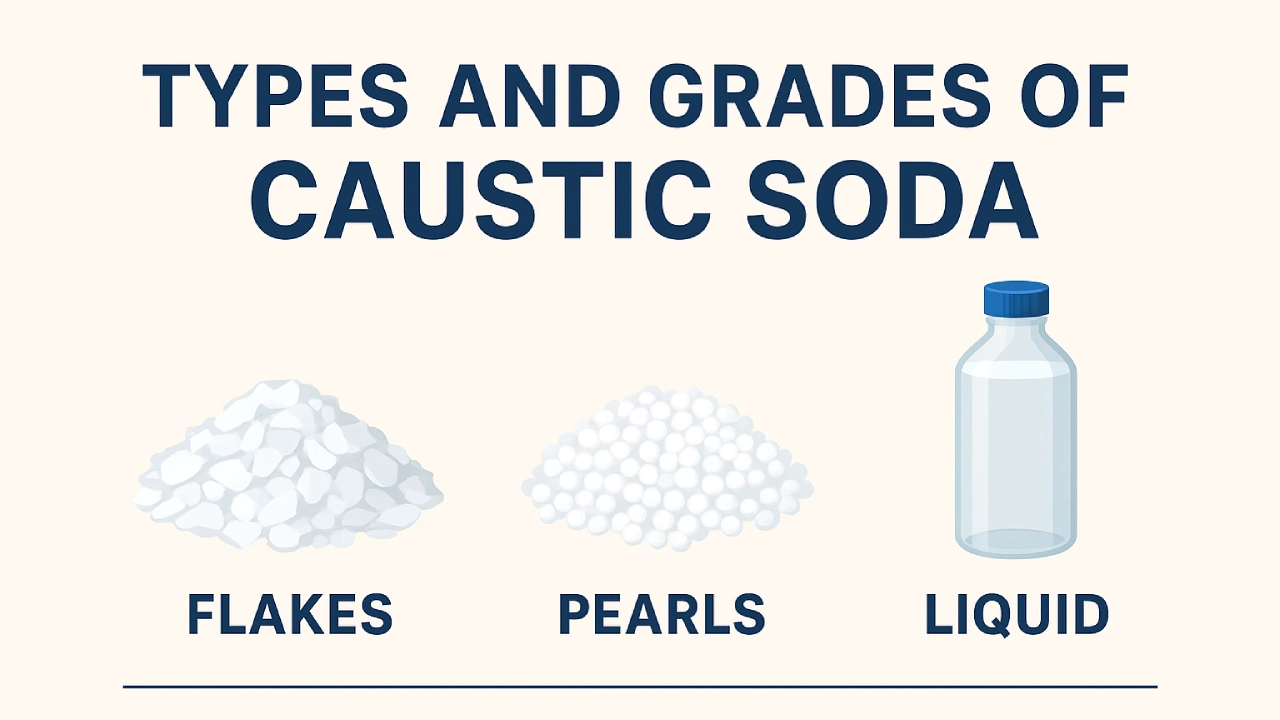Types and Grades of Caustic Soda: Flakes, Pearls, and Liquid

Descriptions of Caustic Soda
Caustic soda, also known as sodium hydroxide (NaOH), is a fundamental chemical in industrial applications ranging from pulp and paper production to water treatment, chemical manufacturing, and cleaning agents. Understanding the different types and grades of caustic soda is essential for selecting the right product for your specific needs.
Types of Caustic Soda
Caustic soda is typically available in three main forms: flakes, pearls, and liquid. Each type has unique characteristics and applications.
1. Caustic Soda Flakes
Caustic soda flakes are solid, white, and brittle pieces of sodium hydroxide. They are produced by evaporating caustic soda solution under controlled conditions. Flakes are popular due to their ease of storage, transport, and controlled handling.
Applications:
-
Soap and detergent production
-
Pulp and paper industry
-
Water treatment and pH control
-
Chemical manufacturing
Advantages:
-
High purity
-
Long shelf life
-
Easy measurement for precise dosing
2. Caustic Soda Pearls
Caustic soda pearls are small, bead-like granules of NaOH. They are slightly more compact than flakes and are easy to handle and store. Pearls are preferred in industries where dust minimization and fast dissolution are important.
Applications:
-
Detergent and cleaning agent production
-
Industrial chemical processes requiring rapid dissolution
-
Applications where a uniform particle size is crucial
Advantages:
-
Less dusty than flakes
-
Quick and uniform dissolution in water
-
Convenient for automated feeding systems
3. Caustic Soda Liquid (50% Solution)
Caustic soda liquid is a concentrated aqueous solution of sodium hydroxide, usually at 50% concentration. It is commonly used in industries that require direct incorporation of NaOH into chemical processes without the need to dissolve solid forms.
Applications:
-
Industrial wastewater treatment
-
Alkali saponification in soap production
-
Chemical manufacturing processes require continuous feeding
Advantages:
-
Ready-to-use solution
-
Eliminates the dissolution step
-
Reduces handling hazards of solid forms
Grades of Caustic Soda
Caustic soda is available in different grades depending on purity, chemical composition, and intended use. The main grades include:
1. Technical or Industrial Grade
-
Purity: Typically 96–99%
-
Commonly supplied in flakes, pearls, or liquid form
-
Suitable for general industrial applications like pulp and paper, textiles, water treatment, and chemical production
2. Food Grade
-
High purity with minimal impurities
-
Approved for use in food processing, such as peeling fruits, chocolate production, and caramel coloring
-
Often supplied in flakes or liquid form
3. Laboratory or Reagent Grade
-
Ultra-high purity (≥99%)
-
Used in laboratories and chemical research
-
Strict quality control to ensure minimal contaminants
4. Specialty Grades
-
Customized to meet specific industrial needs
-
Can include low-sodium or low-chloride variants for sensitive chemical processes
Handling, Storage, and Transportation
-
Flakes and pearls: Store in dry, cool areas in tightly sealed containers to prevent moisture absorption. Avoid contact with metals and skin.
-
Liquid caustic soda: Store in corrosion-resistant containers, away from acids and incompatible chemicals. Use proper personal protective equipment (PPE) when handling.
Packaging Details
-
Flakes and pearls: 25 kg, 50 kg, or bulk bags
-
Liquid caustic soda: 30–1000 L drums, IBC tanks, or bulk tankers
Technical Data Sheet (Typical)
| Property | Flakes / Pearls | Liquid (50%) |
|---|---|---|
| Purity (NaOH) | 96–99% | 48–50% |
| Appearance | White solid (flakes/pearls) | Clear, colorless liquid |
| Moisture Content | ≤2% | 50% |
| Density | 2.13 g/cm³ (solid) | 1.52 g/cm³ |
| Solubility | Soluble in water | Already in solution |
Conclusion:
Choosing the right type and grade of caustic soda is crucial for industrial efficiency and safety. Flakes and pearls are ideal for applications requiring precise dosing and storage, while liquid caustic soda suits continuous processes needing ready-to-use solutions. Matching the appropriate grade to your application ensures optimal performance, cost-effectiveness, and compliance with safety standards.

